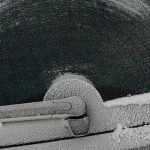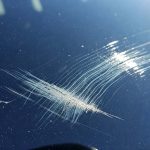
If your windshield cracks, you are dealing with a damaged safety component. This decision could affect your vehicle’s safety, warranty, and resale value. In Canada, every replacement windshield must meet basic safety standards, but that does not mean all auto glass is equal.
According to Transport Canada, laminated glass is required in all windshield replacements to meet safety retention standards in crashes. Beyond this baseline, most replacements fall into one of two categories: OEM (Original Equipment Manufacturer) or OEE (Original Equipment Equivalent).
This article explains the difference between OEM and OEE glass so you can make an informed decision, especially if your vehicle includes Advanced Driver-Assistance Systems (ADAS).
What Is OEM Glass?
OEM glass is manufactured by the same company that supplied your vehicle’s original windshield. It matches the exact specifications for shape, thickness, fit, tint, and optical clarity. Most OEM windshields also include the vehicle brand’s logo.
OEM windshields are engineered to meet tight tolerances, often within 0.5 mm, and are tested extensively for structural integrity and distortion. This level of precision is important for vehicles equipped with ADAS technologies like lane departure warnings or adaptive cruise control, which rely on clear and accurate readings from sensors mounted on or near the windshield.
Because of this, major automakers such as Toyota, Ford, and BMW recommend OEM windshields to preserve the intended functionality of their safety systems. OEM glass is also typically covered under the vehicle’s original warranty.
However, OEM windshields cost more than their counterparts. They are often 20 to 30 percent more expensive and may be harder to source, especially for newer or less common models.
What Is OEE Glass?
OEE (Original Equipment Equivalent) glass is produced by third-party manufacturers and is designed to meet the same safety and performance standards as OEM glass. In many cases, the same global manufacturers produce both OEM and OEE windshields, using similar materials and processes. These include companies like Pilkington, Saint-Gobain, and Fuyao.
The primary difference is that OEE glass does not carry the carmaker’s logo and may have slightly looser tolerances. While high-quality OEE glass can provide the same safety and performance as OEM, lower-end OEE products may have noticeable drawbacks. These can include minor shape deviations, optical distortion, or lack of advanced coatings that reduce noise and block UV rays.
In short, the term “OEE” only guarantees that the glass meets the minimum standards—it does not guarantee the same level of performance unless you know the brand and manufacturer behind it.
Comparing OEE vs OEM Windshields
| Feature | OEM Windshield | OEE Windshield |
| Manufacturer | Original vehicle supplier | Third-party (may also supply OEM) |
| Branding | Includes vehicle brand logo | No brand logo |
| Fit and Finish | Exact match to factory specs | Intended to match, may have slight variations |
| ADAS Compatibility | Guaranteed alignment and clarity | Varies by brand and quality |
| Acoustic and UV Protection | Often includes premium coatings | May not include advanced features |
| Optical Clarity | Fully tested for distortion | Quality depends on manufacturer |
| Cost | 20 to 30 percent more expensive | More affordable |
| Availability | Limited to dealerships or authorized shops | Widely available |
| Warranty | Backed by vehicle manufacturer | Backed by installer or aftermarket company |
| Resale Value Impact | Positive (preserves original condition) | Varies (neutral to negative depending on quality) |
How to Get OEM Windshield Replacement
To get an OEM windshield replacement, visit a dealership or a certified auto glass shop that can order OEM parts. Some insurance companies will only cover OEE unless you specifically request OEM and pay the difference out of pocket. If your vehicle has ADAS, you may be able to justify OEM replacement for safety reasons.
When booking a service:
- Confirm that the replacement will be OEM glass (ask for proof or marking confirmation).
- Ask if ADAS recalibration is included in the cost.
- Make sure the installer is certified and familiar with your vehicle make and model.
This is how to get OEM windshield replacement without compromising safety or warranty.
The Difference Between OEM and Aftermarket Windshield Glass
The main difference between OEM and aftermarket windshield options is in the level of engineering precision. OEM glass is built with tighter specs, tested more thoroughly, and comes with brand backing. Aftermarket glass labeled as OEE may be equal in quality, but that depends entirely on the manufacturer.
Also, keep in mind that certain aftermarket options may be more prone to fogging or condensation issues. You can prevent this by following proper defrosting techniques, such as those outlined in our guide on how to prevent frost on your windshield overnight.
Why Knowing The Difference Matters
The difference between OEM and aftermarket windshield glass becomes more important as vehicles become more advanced. Even small shape or clarity differences can interfere with the proper functioning of safety systems.
Installing a lower-quality aftermarket windshield (even if labeled as OEE) without recalibrating the ADAS components can result in faulty sensor readings or system failure. This can reduce safety and potentially lead to warranty disputes with the manufacturer.
ADAS-related issues also increase the risk of windshield scratches due to misaligned wipers or improper mounting. For guidance on keeping your glass clear and damage-free, read how to prevent and remove windshield scratches.
Is OEM Windshield Better?
The answer depends on your vehicle. For newer models with ADAS, OEM is often the better choice due to exact fit, guaranteed compatibility, and warranty protection. If your vehicle does not use advanced sensors or cameras, a high-quality OEE windshield can still meet your needs while offering cost savings.
However, to avoid problems, always choose a known manufacturer and use a shop that offers proper calibration and installation services.
Final Considerations
Choosing between OEM and OEE glass is not just a question of price. You need to weigh:
- The age and complexity of your vehicle.
- Whether it includes ADAS or camera-based safety systems.
- The quality and reputation of the installer and glass manufacturer.
- Your warranty coverage and insurance policy.
If you are unsure, a trusted technician can help explain what is OEM windshield glass, what your vehicle requires, and whether OEM or high-grade OEE is the right fit.
Initial savings from a low-cost OEE windshield may result in higher long-term costs due to recalibration issues, repeat service visits, or loss of resale value.Need a replacement quote for OEM or OEE glass? Get a personalized quote today and speak with our certified technicians about the best option for your vehicle.


